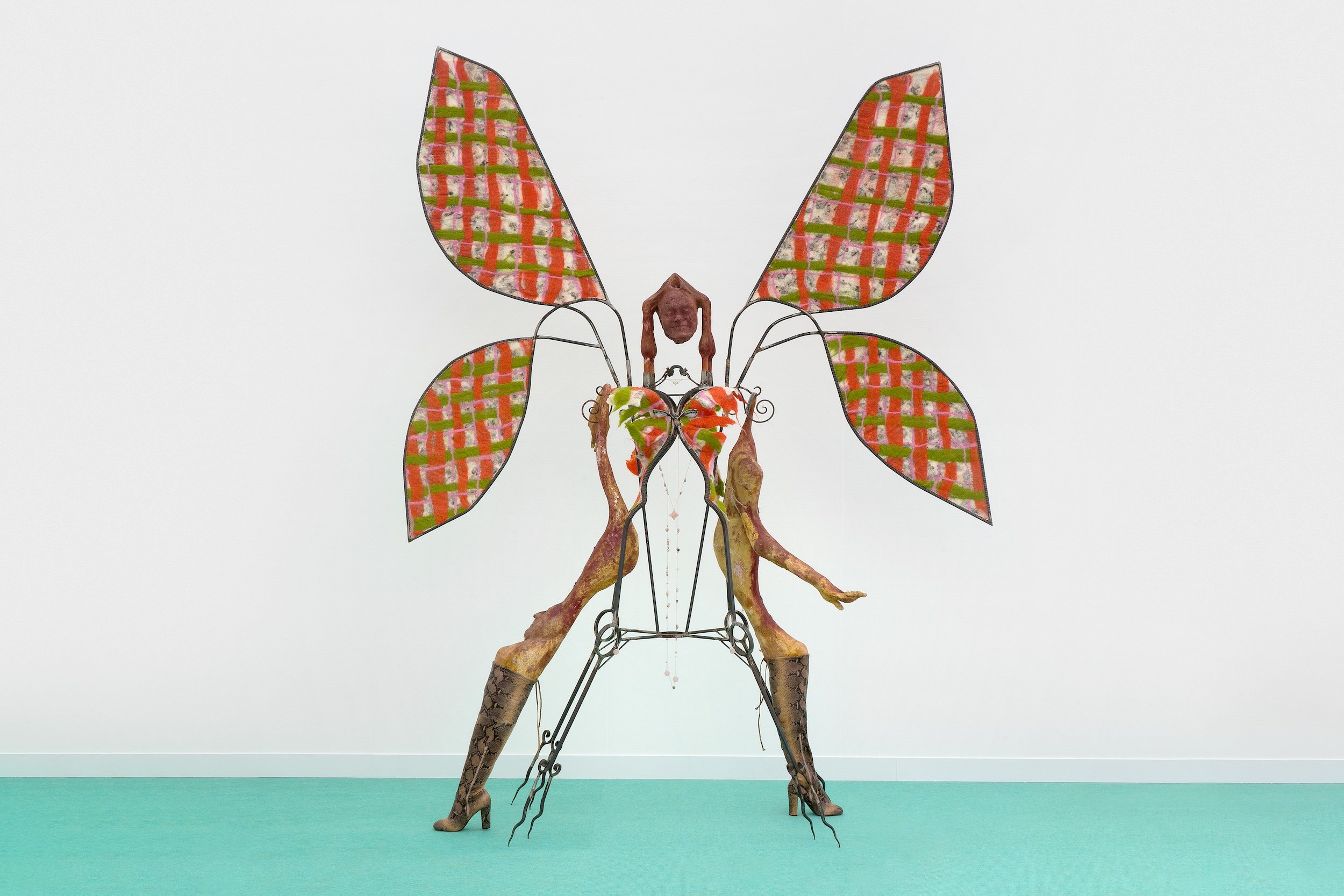
It’s been a rainy, foggy Frieze London, but for many (myself included), that only adds to the allure of the city once known as The Smoke. On the fair’s opening day, the gray skies made the rolling green lawns of Regent’s Park appear that much more lush and the bustle of activity inside the big tent that much more inviting.
While many people say that dealers are saving their best material for next week’s activities in Paris, there is certainly a lot of excitement here in Great Britain. Below are a handful of booths that caught my eye and my imagination, and perhaps yours too. Let’s dive in!
Bani Abidi at Experimenter
Bani Abidi’s solo booth at Experimenter, “Fragments from a nightmare.” Courtesy of Experimenter.
Experimenter perhaps benefitted the most from Frieze London’s decision to reshuffle its floor plan, prioritizing smaller galleries up front and stationing blue-chippers in back. At booth A16, the Mumbai-based gallery is front-and-center upon entry. It used that platform magnificently, presenting a suite of photographs by Pakistani artist Bani Abidi titled “Fragments from a nightmare.”
The photographs, which can be purchased as an editioned set for $150,000, show Abidi in several awkward positions, seated on a mid-century, German-designed chair, expanding on Bruno Munari’s notorious 1944 piece “Seeking comfort in an uncomfortable chair.” The artist splits her time between Berlin and Karachi, and uses this visual language to express her discomfort over Germany’s recent border crackdown.
Chairs are, of course, meant to provide comfort. Abidi looks at German industrial design forged in the 20th century and couples it with the country’s turbulent and violent history. For whom are these chairs meant to comfort?
Nils Alix-Tabeling at Public Gallery
Nils Alix-Tabeling, La Déesse de Montbouy , 2024. Courtesy of Public Gallery.
Some of the most eye-catching sculptures in the fair’s “Focus” section reside in the booth of London’s Public Gallery, where Nils Alix-Tabeling’s piece La Déesse de Montbouy stands in a corner, looming over the aisles. The imposing, spectral force is an interpretation of the Mother Earth deity, and more specifically, according to gallery director Harry Dougall, “the Celtic grotesque called sheela na gig, composed of castings from the artist’s body,” as well as bits of tripe and river pearls collected from the pre-Roman pagan temple near the artist’s studio in rural France. Tattered plaid wings and a pair of snakeskin boots modernize the goddess figure, nodding to modern drag performance and the tradition of camp. Other wall works and sculptures, all priced between £8,500 and £18,500 (about $11,000 to $24,000), are equally as occult and absurd, and worth more than a second look.
Charlotte Edey at Ginny on Frederick
Ginny on Frederick’s solo presentation of work by Charlotte Edey titled “Thin Places.” Courtesy of Ginny on Frederick.
Ginny on Frederick’s founder, Freddie Powell, described his solo exhibition of work by Charlotte Edey in a series of binaries: “They’re bodily and they’re architectural, they’re inside and they’re outside, they’re light and they’re dark. They’re imagined landscapes that she calls ‘Thin Places.’” Housed within bespoke wooden frames, the works remind me of the opening credits of The Twilight Zone, where clocks, moons, eyeballs, and other ominous symbols cut through an otherwise abstract environment. Impressively, the gallery was able to install two stained-glass windows in its booth, which has a rich brown carpet, making the experience of viewing Edey’s work (priced between £10,000 to £12,500, or $13,000 to $16,000) somewhat monastic.
Polly Apfelbaum at Frith Street Gallery
Polly Apfelbaum’s solo presentation with Frith Street Gallery. Courtesy of Frith Street Gallery.
Another booth that contains its own universe belongs to Frith Street Gallery, which has a vibrant Polly Apfelbaum presentation. Stark red-and-white striped walls hold four ceramic wall pieces by the 69-year-old artist priced between £30,000 to £45,000 (about $40,000 to $59,000). One of the artist’s famed “fallen paintings,” a fabric floor piece, is priced at £75,000 ($98,000) and incorporates imagery from “The Potential of Women,” a series that culls forms from the modernist graphic designer Rudolph de Harak’s book of the same name. The tome attempts to imagine an optimistic feminist future, but Apfelbaum has criticized it as condescending to women.
Group presentation at Josh Lilley
Timothy Lai, A Much Needed Gesture, 2024. Courtesy of Josh Lilley.
A formative experience of art, for me, was walking around the Prado as a teenager and being stopped in my tracks by Goya’s famous piece El Perro (ca. ca. 1819–23). Timothy Lai’s painting A Much Needed Gesture at Josh Lilley’s booth borrows that jarring composition, but whereas Goya’s evokes feelings of fear and nihilism, Lai’s version, priced at $35,000, is based more in solace and vulnerability. Elsewhere, a sense of otherworldliness engulfs the booth. A mystic claw cast in aluminum by Sula Bermudez-Silverman grasps a clear orb with a surreal, Boschian bug in it ($35,000), Nick Goss’s eerie painting of what seems to be an empty circus stage with a clamoring audience (£55,000 or about $72,000) sits starkly behind it, and Tom Anhult’s painting of an alien abduction under purple moonlight ($80,000) holds court behind the desk. The booth is a narrative of uncanny, dream-like expressions from start to finish.